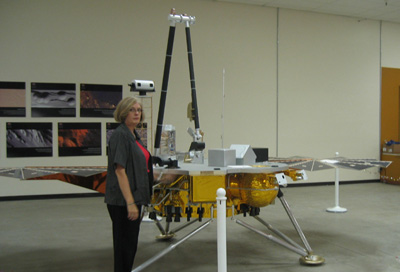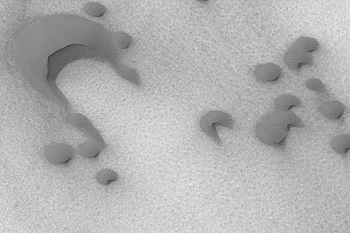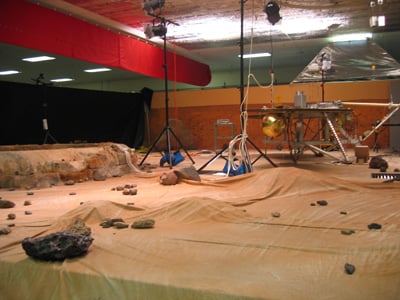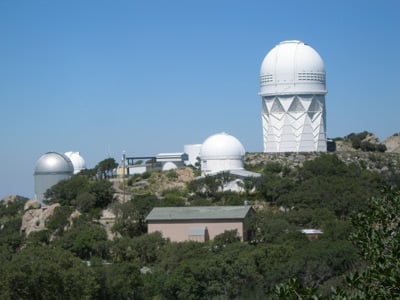Original URL: https://www.theregister.com/2007/10/14/mars_from_the_ashes/
A private view of Phoenix and Mars
It's further from Tucson than you'd think
Posted in Science, 14th October 2007 06:02 GMT
Peter Smith is counting down to the white-knuckle day of his life. On May 25 next year, the Phoenix Mars lander is due to touch down on the Mars surface. If all goes well, over the following 24 to 48 hours the lander's solar panels will extend and the lander will start the science experiments it's there to conduct. As the mission's principal investigator, Smith has everything invested in a safe landing.
Most talk about the Mars mission is about the chances of proving whether there has ever been life on Mars.
"What I hope that we can find – and I have no way of knowing – is that the ice preserves the organic material that has at least fallen on Mars over the last four billion years," Smith says. "A lot of it comes from asteroids and comets – you find organics on the Moon, for gosh sake. Why don't you find it on Mars?"
The absence of that material led people to think for much of the 20th century that there never had been life on Mars: without carbon, no life. On this mission, if they don't find organic material that doesn't prove it's not there; it just means it's not where they've looked. Ice lies under the surface of 25 percent of the planet, and they're going to land in one spot and dig one trench. What are the chances?

Smith is speaking to us in the Lunar and Planetary Laboratory at the University of Arizona, in Tucson. Being based in Tucson and heading up a mission called Phoenix is a little confusing, since the two cities are only separated by a two hour drive. But these people are rocket scientists, and they can cope, even if the politics are the same as if you created an "Edinburgh mission" in Glasgow.
In fact, the Phoenix name refers to the fact that this mission has risen out of the ashes of the two failed Mars missions that preceded it.
The 1999 crash of the Mars orbiter effectively cancelled the planned 2001 mission and put the scientific instruments Smith had developed for those missions into cold storage. When NASA decided to let science lead a mission to Mars for the first time and requested proposals, Smith saw the opportunity. NASA had, he explains, done science-led missions before – most notably Deep Impact, in which NASA drove a spacecraft into a comet to study its composition and therefore that of the solar system – but this was the first to Mars.
Sunken dream
The question Smith had to answer: Where should the mission go? It's a big planet. Then, in 2003, the Mars Orbiter sent back pictures showing water-ice under the poles. The timing of the launch opportunity knocked out the South Pole, which would be wholly dark at that time of year. Therefore: the North Pole.

The exact landing site is still undetermined, awaiting higher-resolution pictures from the Mars Reconnaissance Orbiter. The general area is known, a site of about 250 square miles around the North Pole. But it has to be safe for the lander, which means no big boulders and no steep slopes. At least one candidate spot has already been rejected because better pictures showed it was studded with boulders the size of mini-vans.
Smith's office is tucked away around the corner from a large warehouse-like area that houses two full-scale copies of the lander, one out on the floor and the other positioned on a sort of stage set dressed up in an approximation of the Mars surface. The really noticeable thing - it's really small, considering it's travelling 35,000,000 miles across space. With the solar panels extended, it's only about 18 feet across and weighs only 772 pounds. (At launch, it weighed 1,477 pounds – it used up fuel and has jettisoned a rocket or two since then.)
Assuming all goes well and it lands safely, it will run for 90 days until the oncoming Martian winter takes away the sun it needs to run the instruments and puts it to sleep. Meanwhile, in a large room near Smith's office that's divided into signposted sections for atmosphere, biological potential, chemistry, and geology, some 70 to 80 scientists will be losing their minds living on Martian time and arguing daily over how much of the lander's power to allocate to each section. The key instrument on the lander is the eight-foot robot arm that will scoop up soil samples for closer examination. Besides that, the lander has five cameras, an oven, and a gas spectrometer.
Until the robot arm digs up samples so they can be microscopically examined, the team can't be absolutely sure it's water under that surface. But, says, Smith, they're sure it's hydrogen-rich, and that limits the possiblities. It can't be pure hydrogen – as a gas, it would just float away. The most likely thing for hydrogen to combine with is oxygen – which is water. But at those temperatures, any water will be frozen.
"The only other possibility," says Smith, "is oil."
Water isn't a guarantor of life, but life as we know it requires water. Certainly, Smith says, it requires some kind of fluid, if only because molecules can only move if they're suspended in fluid. It might not be life as we usually think of it; we could be talking about tiny creatures that can live in monolayers of water. This sounds less far-fetched than it might elsewhere, since the Sonoran Desert Museum, about 30 miles away, keeps displays of desert fish, which can survive in the slightest wisps of puddles.
But Smith has other interests, equally important. "We have a lot of other science goals that have nothing to do with life. The hydrological cycle, the weather cycle, the properties of the ice – all these things tell us about the history and how the planet works as a planet. Those really are true science goals. The thing about life is a hope."

Look at those cavemen go
The idea of life on Mars is the stuff science fiction is made of, and like many scientists Smith says he loved sci-fi as a child. "I liked flying around in rocket ships," he says, recalling a favourite book called Rocket Jockey. "Zipping around between the planets and having great adventures with Titanians and Centurnions. I was 12 years old, I loved it." It didn't occur to him to become an astronaut, however: the moon landing happened while he was in college. "I thought, well, I missed that chance." There were opportunities when the space shuttle started, but by then, "I was not in that frame of mind."
The influence remained. "That youthful fascination with the unknown – it certainly drove me towards science." He mentions Tom Swift "and his incredible earth-digging machine – he invents devices in his back yard and for example digs down to the centre of the earth with it. He could do anything, and I thought well, if I had a laboratory in my back yard I could do anything too."
If you were going to have such a thing, Tucson would probably be the place. Aside from its long connections with the space programme – the walls of this building, owned by the University of Arizona, are lined with posters and pictures commemorating the university's involvement with a long line of previous NASA missions – astronomy seems to be the local industry. Tucson is the ideal destination for the astronomy tourist.
Although the Mars lander work is not open to the public, most of the other astronomy-related resources are. Also at the University of Arizona, the Flandrau Planetarium has daily shows and a publicly accessible telescope. If you have a car – almost inescapable in Tucson – you can combine a drive in Arizona's glorious desert with a visit to any one of a number of observatories.

"The city is surrounded by mountains," says astronomy writer Ian Ridpath, "and it seems that almost every peak has a telescope on it." Tucson even has local ordinances designed to minimise light spill so the astronomers will have the best possible viewing conditions, and the Tucson air is exceptionally clear and dry.
The premium visit is to Kitt Peak, about an hour and a half by car from downtown Tucson. The last 12 miles of that drive are a steep climb: the observatory is 6,900 feet up. Astronomers from all over the world apply to use its facilities. Despite a two-month monsoon season in July and August, the observatory averages over 250 nights a year of good viewing. Which explains why, as you walk past the signs warning of venormous snakes, you also pass dormitories with signs asking you to keep the noise down because of "day sleepers".
It's a good trip even if you aren't entranced by the many scopes up there, which include a solar telescope, a radio telescope and, the biggest in the collection, a four-metre job. The 2.1 metre scope at Kitt Peak is nearly the same size as Hubble, and was one of the first robot-controlled scopes. In fact, it was practice for Hubble.
Hooked to the silver screen
But that's just Earth-based tourism. Of the Phoenix mission, NASA says it expects the ice layer on Mars to begin just inches below the soil. Once Phoenix has unfurled its 18 foot wide solar panels and powered up, it will start to dig down using its robotic arm. The arms is tipped with a camera and a conductivity probe to examine the surface before samples are collected and lifted to the lander's two analysis instruments. At least one sample will be heated to check for volatiles such as water and organic molecules. The second instrument will examine the chemistry of the soil.
The tradition of astronomy is now deeply embedded in Arizona, (the stargazing conditions are so good that even the Vatican has a telescope here, from which it runs research in partnership with the University of Arizona) so it makes a nice kind of sense that a mission to find water in the greatest, coldest desert in our solar system will be run from one of the most beautiful deserts on Earth.®